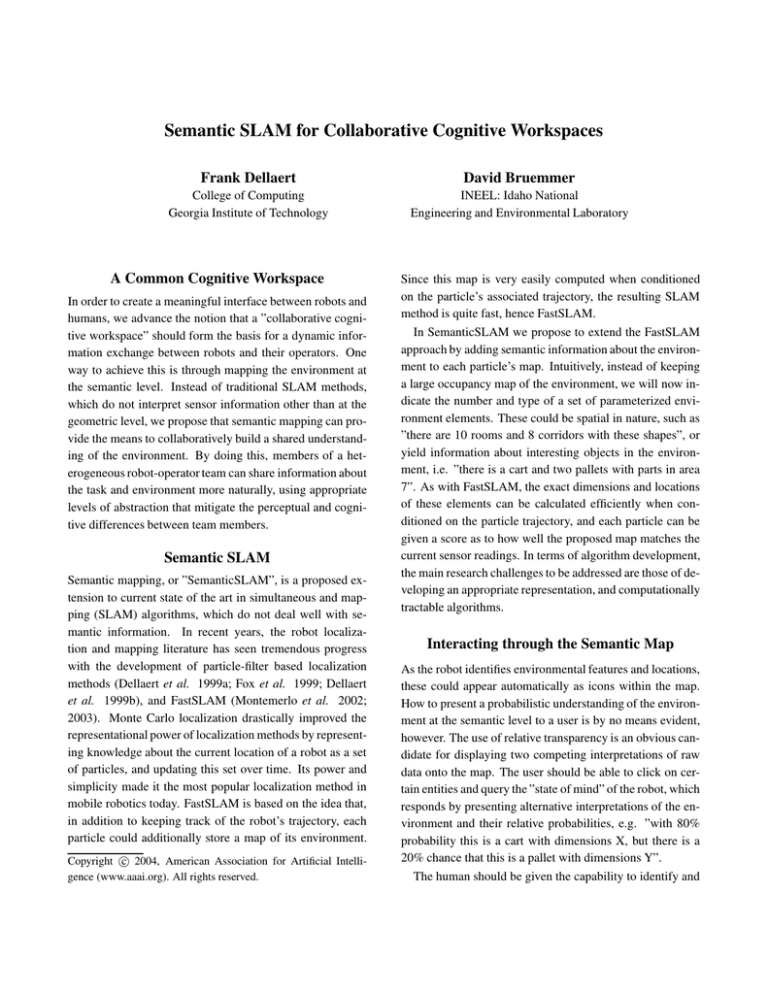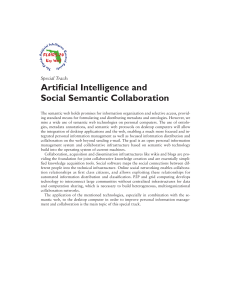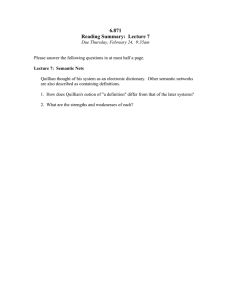
Semantic SLAM for Collaborative Cognitive Workspaces
Frank Dellaert
David Bruemmer
College of Computing
Georgia Institute of Technology
INEEL: Idaho National
Engineering and Environmental Laboratory
A Common Cognitive Workspace
In order to create a meaningful interface between robots and
humans, we advance the notion that a ”collaborative cognitive workspace” should form the basis for a dynamic information exchange between robots and their operators. One
way to achieve this is through mapping the environment at
the semantic level. Instead of traditional SLAM methods,
which do not interpret sensor information other than at the
geometric level, we propose that semantic mapping can provide the means to collaboratively build a shared understanding of the environment. By doing this, members of a heterogeneous robot-operator team can share information about
the task and environment more naturally, using appropriate
levels of abstraction that mitigate the perceptual and cognitive differences between team members.
Semantic SLAM
Semantic mapping, or ”SemanticSLAM”, is a proposed extension to current state of the art in simultaneous and mapping (SLAM) algorithms, which do not deal well with semantic information. In recent years, the robot localization and mapping literature has seen tremendous progress
with the development of particle-filter based localization
methods (Dellaert et al. 1999a; Fox et al. 1999; Dellaert
et al. 1999b), and FastSLAM (Montemerlo et al. 2002;
2003). Monte Carlo localization drastically improved the
representational power of localization methods by representing knowledge about the current location of a robot as a set
of particles, and updating this set over time. Its power and
simplicity made it the most popular localization method in
mobile robotics today. FastSLAM is based on the idea that,
in addition to keeping track of the robot’s trajectory, each
particle could additionally store a map of its environment.
c 2004, American Association for Artificial IntelliCopyright gence (www.aaai.org). All rights reserved.
Since this map is very easily computed when conditioned
on the particle’s associated trajectory, the resulting SLAM
method is quite fast, hence FastSLAM.
In SemanticSLAM we propose to extend the FastSLAM
approach by adding semantic information about the environment to each particle’s map. Intuitively, instead of keeping
a large occupancy map of the environment, we will now indicate the number and type of a set of parameterized environment elements. These could be spatial in nature, such as
”there are 10 rooms and 8 corridors with these shapes”, or
yield information about interesting objects in the environment, i.e. ”there is a cart and two pallets with parts in area
7”. As with FastSLAM, the exact dimensions and locations
of these elements can be calculated efficiently when conditioned on the particle trajectory, and each particle can be
given a score as to how well the proposed map matches the
current sensor readings. In terms of algorithm development,
the main research challenges to be addressed are those of developing an appropriate representation, and computationally
tractable algorithms.
Interacting through the Semantic Map
As the robot identifies environmental features and locations,
these could appear automatically as icons within the map.
How to present a probabilistic understanding of the environment at the semantic level to a user is by no means evident,
however. The use of relative transparency is an obvious candidate for displaying two competing interpretations of raw
data onto the map. The user should be able to click on certain entities and query the ”state of mind” of the robot, which
responds by presenting alternative interpretations of the environment and their relative probabilities, e.g. ”with 80%
probability this is a cart with dimensions X, but there is a
20% chance that this is a pallet with dimensions Y”.
The human should be given the capability to identify and
classify targets in the environment using an interactive visual display, which could be used as additional constraints
by a semantic mapping approach. If the operator has more
information available than the robot, the user could add, verify, remove, or annotate abstractions within the map. Collaborative construction of the map would enhance each individual team member’s understanding of the environment
and provides a shared cognitive workspace for the humanrobot team to communicate about the environment. The
robot could use the map to communicate about the task
and environment both graphically (e.g., ”The highlighted
area has been searched!”) and verbally (”Rock 2 found near
’Obstacle 3’”) using the semantic names designated within
the shared cognitive workspace. The human team members
could use the map abstractions for tasking either graphically
(e.g., ”Search this region for temperatures above 80 0F!”) or
verbally (”Go to Rock 5!”).
Supporting Planning and Decisions
In addition to communication, the probabilistic semantic
information could also be used in planning and decisionmaking. Expanded planning capabilities based on user preferences and semantic maps could support semi-autonomous
navigation that alleviates the problems arising from communication delays. The capability of representing a probability distribution over semantic interpretations of the environment opens up novel ways to plan and communicate about
plans. The user could provide input about risk attitude, e.g.
”avoid this outcome at all cost”, ”be conservative”, or ”be
optimistic”, and high level goals that can be communicated
at a semantic level to the robot, e.g. ”go to the red room”.
Plans can be constructed on the expected utility of a certain path or behavior, where now the utility can depend on
semantic properties of the environment. As a concrete example, if a certain path is chosen that with 10% probability
has a blockage (closed door, large obstacle), the expected
time to complete a task (”get out of the building”) could be
unacceptably long. The proposed work will provide both
the means to communicate about risk and plan goals, based
on the semantic map representation afforded by SemanticSLAM, as well as adapt existing utility-based planning algorithms to deal with such (probabilistic) semantic maps.
Conclusion
By marrying probabilistic SLAM methods and object recognition, ”semantic SLAM” will bring map building for robots
to the next level, enabling meaningful interactions between
humans and robots, and supporting planning and decisionmaking at the mission-level. These capabilities are essential
as we approach an era in which robots will play an increasingly important role in both military and non-military applications of the future.
References
Dellaert, F.; Fox, D.; Burgard, W.; and Thrun, S. 1999a.
Monte Carlo Localization for mobile robots. In IEEE Intl.
Conf. on Robotics and Automation (ICRA).
Dellaert, F.; Fox, D.; Burgard, W.; and Thrun, S. 1999b.
Using the condensation algorithm for robust, vision-based
mobile robot localization. In IEEE Conf. on Computer Vision and Pattern Recognition (CVPR).
Fox, D.; Burgard, W.; Dellaert, F.; and Thrun, S. 1999.
Monte Carlo Localization – Efficient position estimation
for mobile robots. In AAAI Nat. Conf. on Artificial Intelligence.
Montemerlo, M.; Thrun, S.; Koller, D.; and Wegbreit, B.
2002. FastSLAM: A factored solution to the simultaneous
localization and mapping problem. In AAAI Nat. Conf. on
Artificial Intelligence.
Montemerlo, M.; Thrun, S.; Koller, D.; and Wegbreit, B.
2003. FastSLAM 2.0: An improved particle filtering algorithm for simultaneous localization and mapping that provably converges. In Intl. Joint Conf. on Artificial Intelligence
(IJCAI).









